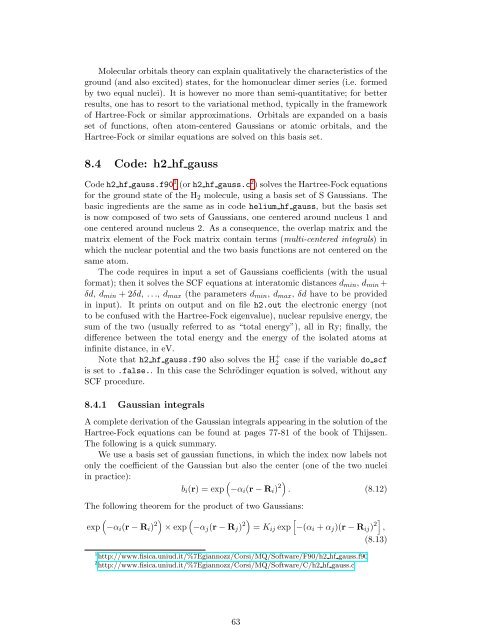Numerical Methods in Quantum Mechanics - Dipartimento di Fisica
Numerical Methods in Quantum Mechanics - Dipartimento di Fisica
Numerical Methods in Quantum Mechanics - Dipartimento di Fisica
Create successful ePaper yourself
Turn your PDF publications into a flip-book with our unique Google optimized e-Paper software.
Molecular orbitals theory can expla<strong>in</strong> qualitatively the characteristics of the<br />
ground (and also excited) states, for the homonuclear <strong>di</strong>mer series (i.e. formed<br />
by two equal nuclei). It is however no more than semi-quantitative; for better<br />
results, one has to resort to the variational method, typically <strong>in</strong> the framework<br />
of Hartree-Fock or similar approximations. Orbitals are expanded on a basis<br />
set of functions, often atom-centered Gaussians or atomic orbitals, and the<br />
Hartree-Fock or similar equations are solved on this basis set.<br />
8.4 Code: h2 hf gauss<br />
Code h2 hf gauss.f90 1 (or h2 hf gauss.c 2 ) solves the Hartree-Fock equations<br />
for the ground state of the H 2 molecule, us<strong>in</strong>g a basis set of S Gaussians. The<br />
basic <strong>in</strong>gre<strong>di</strong>ents are the same as <strong>in</strong> code helium hf gauss, but the basis set<br />
is now composed of two sets of Gaussians, one centered around nucleus 1 and<br />
one centered around nucleus 2. As a consequence, the overlap matrix and the<br />
matrix element of the Fock matrix conta<strong>in</strong> terms (multi-centered <strong>in</strong>tegrals) <strong>in</strong><br />
which the nuclear potential and the two basis functions are not centered on the<br />
same atom.<br />
The code requires <strong>in</strong> <strong>in</strong>put a set of Gaussians coefficients (with the usual<br />
format); then it solves the SCF equations at <strong>in</strong>teratomic <strong>di</strong>stances d m<strong>in</strong> , d m<strong>in</strong> +<br />
δd, d m<strong>in</strong> + 2δd, . . ., d max (the parameters d m<strong>in</strong> , d max , δd have to be provided<br />
<strong>in</strong> <strong>in</strong>put). It pr<strong>in</strong>ts on output and on file h2.out the electronic energy (not<br />
to be confused with the Hartree-Fock eigenvalue), nuclear repulsive energy, the<br />
sum of the two (usually referred to as “total energy”), all <strong>in</strong> Ry; f<strong>in</strong>ally, the<br />
<strong>di</strong>fference between the total energy and the energy of the isolated atoms at<br />
<strong>in</strong>f<strong>in</strong>ite <strong>di</strong>stance, <strong>in</strong> eV.<br />
Note that h2 hf gauss.f90 also solves the H + 2<br />
is set to .false.. In this case the Schröd<strong>in</strong>ger equation is solved, without any<br />
SCF procedure.<br />
8.4.1 Gaussian <strong>in</strong>tegrals<br />
case if the variable do scf<br />
A complete derivation of the Gaussian <strong>in</strong>tegrals appear<strong>in</strong>g <strong>in</strong> the solution of the<br />
Hartree-Fock equations can be found at pages 77-81 of the book of Thijssen.<br />
The follow<strong>in</strong>g is a quick summary.<br />
We use a basis set of gaussian functions, <strong>in</strong> which the <strong>in</strong>dex now labels not<br />
only the coefficient of the Gaussian but also the center (one of the two nuclei<br />
<strong>in</strong> practice):<br />
(<br />
b i (r) = exp −α i (r − R i ) 2) . (8.12)<br />
The follow<strong>in</strong>g theorem for the product of two Gaussians:<br />
(<br />
exp −α i (r − R i ) 2) (<br />
× exp −α j (r − R j ) 2) [<br />
= K ij exp −(α i + α j )(r − R ij ) 2] ,<br />
(8.13)<br />
1 http://www.fisica.uniud.it/%7Egiannozz/Corsi/MQ/Software/F90/h2 hf gauss.f90<br />
2 http://www.fisica.uniud.it/%7Egiannozz/Corsi/MQ/Software/C/h2 hf gauss.c<br />
63
















